
Gordon railway station is a heritage-listed railway station located on the North Shore line, serving the Sydney suburb of Gordon. It is served by Sydney Trains T1 North Shore line and T9 Northern line services. Situated at St Johns Avenue, Gordon in the Ku-ring-gai Council local government area of New South Wales, Australia, the station was designed and built by the New South Wales Department of Railways in 1909. The property was added to the New South Wales State Heritage Register on 2 April 1999.

Newtown railway station is a heritage-listed railway station located on the Main Suburban line, serving the Sydney suburb of Newtown, in New South Wales, Australia. It is served by Sydney Trains T2 Inner West & Leppington line services. The railway station and the Newtown Tram Depot were jointly added to the New South Wales State Heritage Register on 2 April 1999.

Riverstone railway station is a heritage-listed railway station serving the Sydney suburb of Riverstone in New South Wales, Australia. It was designed by the NSW Government Railways and William Weaver and built from 1883 to 1939. The station is located on the Richmond line, and is served by Sydney Trains T1 Western and T5 Cumberland line services. The property was added to the New South Wales State Heritage Register on 2 April 1999.

Richmond railway station is the heritage-listed terminus railway station of the Richmond line, serving the Sydney suburb of Richmond, in New South Wales, Australia. It is served by Sydney Trains T1 Western and T5 Cumberland line services. It was added to the New South Wales State Heritage Register on 2 April 1999.

Bulli railway station is a heritage-listed railway station on the South Coast railway line in New South Wales, Australia, serving the northern Wollongong suburb of Bulli. It was added to the New South Wales State Heritage Register on 30 August 2013.

Kiama railway station is a heritage-listed intercity train station located in Kiama, New South Wales, Australia, on the South Coast railway line. The station serves NSW TrainLink diesel multiple unit trains traveling south to Bomaderry and electric multiple unit trains north to Wollongong and Sydney. Early morning and late night services to and from stations to the south are provided by train replacement bus services. It was added to the New South Wales State Heritage Register on 2 April 1999.
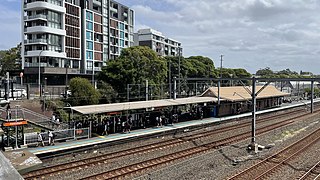
Petersham railway station is a heritage-listed railway station located on the Main Suburban line, serving the Sydney suburb of Petersham. It is served by Sydney Trains T2 Inner West & Leppington line services. It was added to the New South Wales State Heritage Register on 2 April 1999.

Berry railway station is a heritage-listed single-platform intercity train station located in Berry, New South Wales, Australia, on the South Coast railway line. The station serves NSW TrainLink diesel multiple unit trains travelling south to Bomaderry and north to Kiama. Early morning and late night services to the station are provided by train replacement bus services. In the past, the station precinct also catered to freight trains carrying cattle and dairy products.
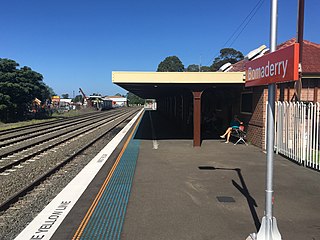
Bomaderry railway station is a heritage-listed single-platform intercity train station located in Bomaderry, New South Wales, Australia, on the South Coast railway line. The station serves NSW TrainLink diesel multiple unit trains to Kiama. Early morning and late night services to the station are provided by train replacement bus services. A siding near the station is used by freight trains operated by the Manildra Group.

St Marys railway station is a heritage-listed former goods yard, railway signal box and now railway station located on the Main Western line in the western Sydney suburb of St Marys in the City of Penrith local government area of New South Wales, Australia. The station is served by Sydney Trains T1 Western line services. The station marks the end of the four-track section of the Main Western line. It was designed by New South Wales Government Railways and was built in 1862. It is also known as St. Marys Railway Station Group and St Marys Railway Station. The property was added to the New South Wales State Heritage Register on 2 April 1999.

Croydon railway station is a heritage-listed railway station located on the Main Suburban line, serving the Sydney suburb of Croydon, New South Wales, Australia. It is served by Sydney Trains T2 Inner West & Leppington line services. The station was designed by NSW Government Railways and built from 1892 to 1927. It was added to the New South Wales State Heritage Register on 2 April 1999.

Wollongong railway station is a heritage-listed railway station on the South Coast railway line in New South Wales, Australia. It serves the central business district of Wollongong. It was added to the New South Wales State Heritage Register on 2 April 1999.

Bundanoon railway station is a heritage-listed railway station on the Main Southern line in New South Wales, Australia. It serves the small town of Bundanoon. It was added to the New South Wales State Heritage Register on 2 April 1999.

Katoomba railway station is a heritage-listed railway station located on the Main Western line in Katoomba, New South Wales, Australia. It serves the Blue Mountains town of Katoomba opening on 2 February 1874 as Crushers, being renamed Katoomba on 9 July 1877.
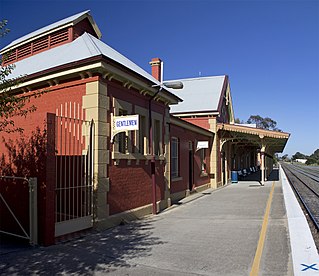
Queanbeyan railway station is a heritage-listed railway station located on the Bombala line in New South Wales, Australia. It serves the town of Queanbeyan.

Orange railway station is a heritage-listed former railway bridge and now railway station located on the Main Western line on Peisley Street, Orange in the City of Orange local government area of New South Wales, Australia. It was built from 1877 to 1950. It is also known as Orange Railway Station and yard group. The property was added to the New South Wales State Heritage Register on 2 April 1999.
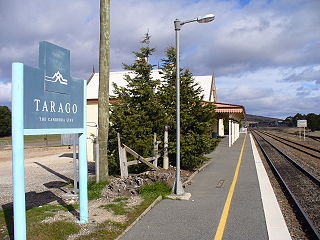
Tarago railway station is a heritage-listed railway station located on the Bombala line in New South Wales, Australia. It serves the town of Tarago. It was built in 1884 by G. & C. Horn. It was added to the New South Wales State Heritage Register on 2 April 1999.

Bungendore railway station is a heritage-listed railway station located on the Bombala line in New South Wales, Australia. It serves the town of Bungendore. The design of the station has been attributed to John Whitton. It was built in 1884-85 by contractor J. Jordan. It was added to the New South Wales State Heritage Register on 2 April 1999.

The Cooma railway station is a heritage-listed former railway station on the Bombala railway line at Bradley Street, Cooma, Snowy Monaro Regional Council, New South Wales, Australia. The original design of the station was attributed to John Whitton. The station complex was built from 1889 to 1950. The Cooma Monaro Railway is based at the station and is opening a heritage railway museum in the restored station building in December 2022. The station was added to the New South Wales State Heritage Register on 2 April 1999.
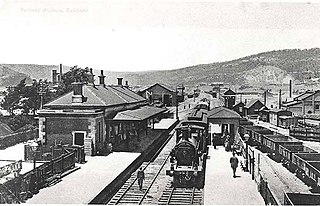
The Eskbank railway station is a heritage-listed former locomotive depot and railway station and now community group venue adjacent to the Main Western Line at Lithgow, City of Lithgow, New South Wales, Australia. It was designed by the New South Wales Government Railways and the station building was built by Goodsell & Wright, as a contractor. It is also known as Eskbank Railway Station group and Lithgow Goods Station/ Lithgow Site S1. The property was added to the New South Wales State Heritage Register on 2 April 1999.




















